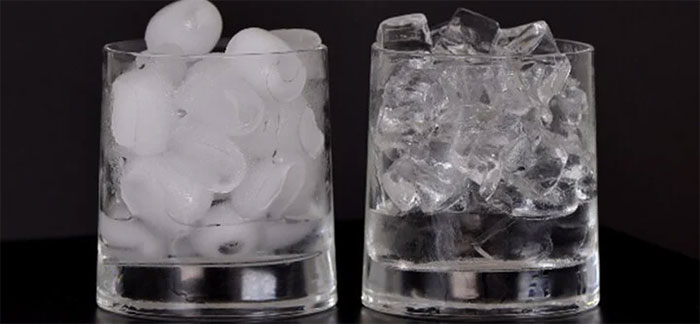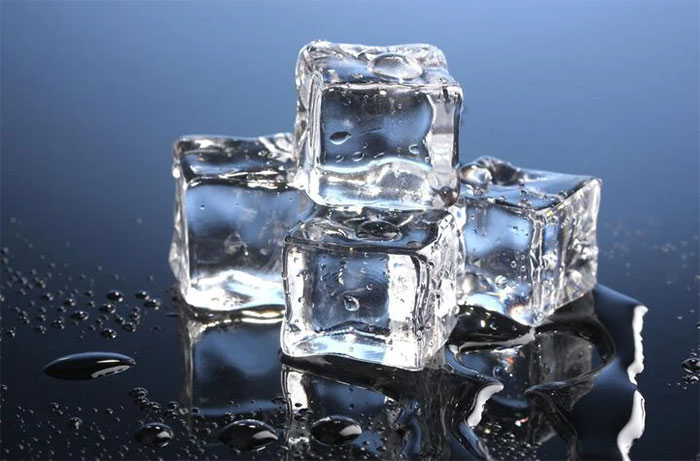Distinguish between ice made from boiled and unboiled water
Color, clarity, melting time. are signs that help you distinguish ice made from boiled and unboiled water.
Unlike ice used to chill food, ice used for drinks such as smoothies, juices, beer. requires very high water quality, especially microbiology. To ensure safety, many people only want to use ice made from heat-sterilized water; However, not everyone knows how to distinguish between stones made from boiled and unboiled water.
 Ice made from boiled water is usually clear, while ice made from unboiled water is less clear. (Photo: Memphis Ice Machine Company)
Ice made from boiled water is usually clear, while ice made from unboiled water is less clear. (Photo: Memphis Ice Machine Company)
According to Scienceabc , although there is not much difference in sense, if you pay close attention, you can distinguish between ice made from boiled and unboiled water through the following signs:
Color and clarity of the stone
Ice made from boiled water, when frozen, will have a clear color, usually transparent and smooth. That's because the boiled water has had air bubbles and some impurities removed during the boiling process. If you use boiled water twice to make ice, the finished product you will get is clear, not cloudy ice.

Ice made from boiled water removes air bubbles and impurities, so it is usually clear. (Photo: Facts).
Ice made from unboiled water is often milky white because it still contains many impurities. Although impurities dissolved in water cannot be seen, when frozen, they accumulate, making the ice cubes cloudy.
'Impurity' does not always mean germs or bacteria. Anything other than water present in the water can be considered an impurity. Unboiled water contains a lot of impurities, but most of them are not harmful to us. In fact, some of them (calcium and magnesium, for example) are actually beneficial for your health. Various impurities also give water its characteristic taste.
The most common impurities found in unboiled water include calcium deposits, fluoride, nitrates, magnesium and several other organic elements that cannot be removed by conventional filtration methods. When water freezes, impurities that are evenly distributed in the water tend to gather near the middle, causing the ice cubes to have a milky white color in the middle.

Ice made from unboiled water is often more opaque due to the many impurities in the water. (Photo: Wikipedia.org).
Note that ice cubes made from distilled water tend to be clearer because distilled water (or even boiled water) does not have as many impurities as tap water.
Solubility
In addition to relying on the color and clarity of the stone, we can distinguish stones made from boiled and unboiled water by its solubility. It sounds complicated, but it's actually very easy.
Ice made from boiled water has had air bubbles and impurities removed, so the structure is more solid and stays cold longer, making it significantly more difficult to melt. When the ice melts, you will see water as clear as mineral water.
Ice made from unboiled water has many impurities, so it is more loosely bonded and dissolves faster. After melting, the water will be cloudy and residue will be clearly visible.
In short, boiled water produces transparent ice cubes, while unboiled water produces more opaque ice cubes. This is the most obvious sign to help distinguish stones made from boiled and unboiled water.
- Mistakes when using cool boiled water to turn it from being good to being a 'disease nest'
- 5 common mistakes when boiled eggs
- Why is there a boiled chicken on New Year's Day, a question that is easy to think but difficult to answer?
- Video: Drop the camera in hot water to spin boiled eggs
- Tips for peeling boiled eggs very fast
- What does it mean when hard boiled eggs appear?
- The river boiled water boiled everything in the Amazon forest
- Top 4 types of harmful water should not be taken immediately after waking up
- Close up of the experiment of boiling corn and sweet potatoes with pine powders
- These vegetables should not be boiled or lose nutrients
- The way to boil duck is delicious, soft, ripe, not bad
- This is why you should never boil or heat eggs in the microwave
 Soaking vegetables in salt water does not remove chemicals but you should still do it
Soaking vegetables in salt water does not remove chemicals but you should still do it You should limit bamboo shoots if you have 1 in 5 of these diseases
You should limit bamboo shoots if you have 1 in 5 of these diseases Mistakes when soaking vegetables in salt water
Mistakes when soaking vegetables in salt water Risk of death when combining shrimp with vitamin C
Risk of death when combining shrimp with vitamin C How do marine animals drink filtered water?
How do marine animals drink filtered water?  Discover the secret of the water buffalo
Discover the secret of the water buffalo  Shocking discovery about the Earth's 'tail'
Shocking discovery about the Earth's 'tail'  Top 10 Unbelievable Ways Animals Survive in Dangerous Environments
Top 10 Unbelievable Ways Animals Survive in Dangerous Environments  Mysterious wonders of the world
Mysterious wonders of the world  The largest animals that lived in the desert, still exist today
The largest animals that lived in the desert, still exist today 